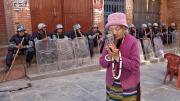In thousands of photographs taken between 1975 and 2011, Kevin Bubriski has helped document the dramatic evolution of daily life in Nepal, from its years as a Hindu kingdom to what he calls “the current precarious peace.”
The artist’s latest book, Nepal: 1975-2011 (published in May by Peabody Museum Press and Radius Books), reveals his favorite prints, 30 of which are on display for the first time in Shadows of Shangri La: Nepal in Photographs, at the Harvard University Asia Center. Ranging from black-and-white portraits of villagers in the 1970s and 1980s to scenes with soldiers during the country’s civil war (1996-2006) and colorful depictions of commercialism and poverty in modern-day Kathmandu, the photographs are not politically driven. Rather, they aim to show “only one person’s experience, not a culture, historic period, ethnographic group, or complex social or economic condition,” he writes. “They are selected moments within the edges of a framed world.”
Bubriski first took pictures in Nepal while surveying and building water systems as a 20-year-old Peace Corps volunteer, adopting the street artist’s approach: “letting people present themselves as they are,” he said in a recent interview from his home in Vermont. One shot taken during the king and queen’s 1978 visit to Jumla (a remote northwestern mountain town that at the time was more than ten days’ walk from the closest road), he caught the awed expressions of residents who, he reports, “revered the king as the reincarnation of the Hindu god Vishnu.”
By 2010, Nepal had become a republic and the royal palace in Kathmandu was a public museum. Checking his camera at the gates, as required, Bubriski toured the monarch’s former bedroom, bathroom, and rear gardens. Markers showed where nine family members were killed in 2001, allegedly by the crown prince. That, he adds, juxtaposed with an image he took outside the palace gates of teenaged Nepalese tourists standing around with their cell phones and cameras, “shows the incredible transformation that has occurred within this country.”
When last in Nepal in 2011, on the Tibetan New Year, Bubriski saw other signs of change while visiting the Boudhanath Stupa, a pilgrimage site for Tibetan Buddhists living in Kathmandu. In the past, people gathered there, perhaps to “throw roasted barley flour in the air and cheer for the new year and the long life of the Dalai Lama,” he explains, but “any political expressions at the Stupa are forbidden now.” He was moved to see one elderly woman in a soft pink hat circumambulating the monument, holding a prayer wheel and rosary beads (above), and framed the moment she passed Nepali policemen in full riot gear waiting, he says, “for a call to action.”









